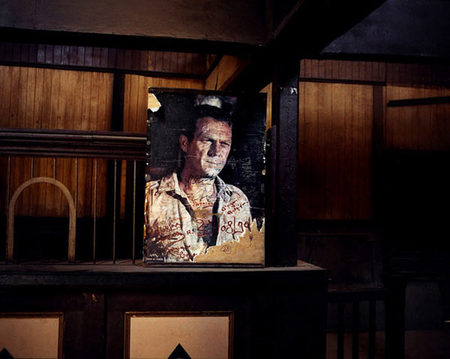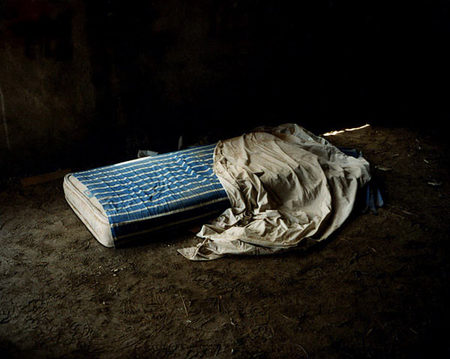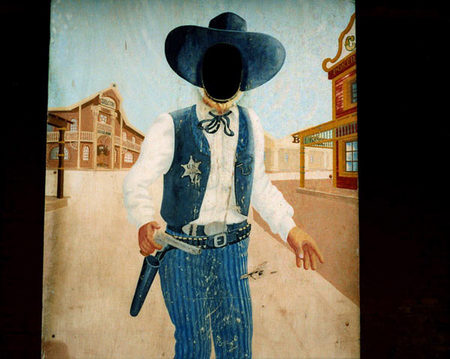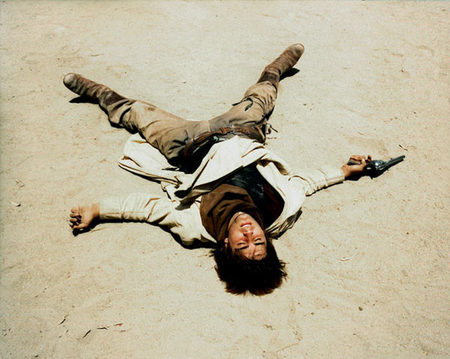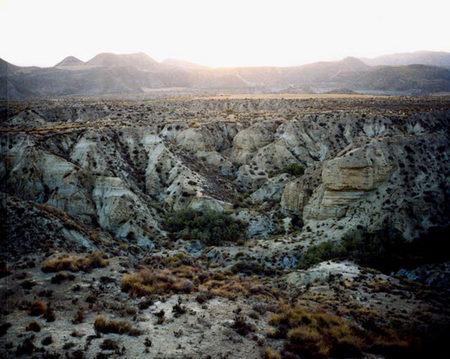A Conversation with Aaron Schuman
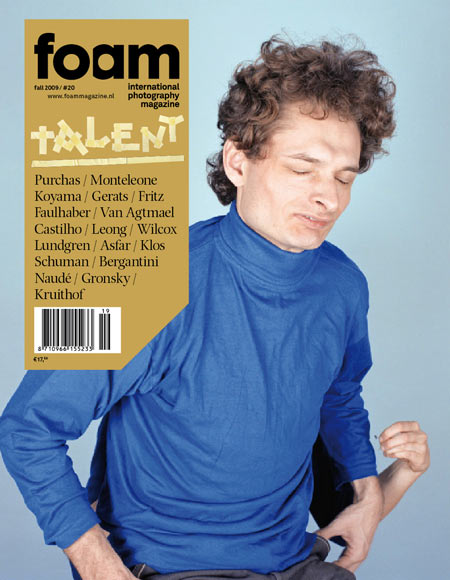
The Fall 2009 edition of FOAM International Photography Magazine is dedicated to showcasing the work of up-and-coming photographers. This year, there are 18 photographers - a very diverse group. FOAM approached me earlier this year to ask whether I was available to conduct interviews with each the photographers, and, of course, I agreed to it. The following conversation with Aaron Schuman is the full version of the abridged one printed in FOAM 20.
Jörg Colberg: Your photographs of sets used for Sergio Leone’s so-called ‘Spaghetti Westerns’ contain so many subtle aspects that it’s hard to know where to start. So maybe here: How did you come up with this idea?
Aaron Schuman: I’m from America, but before I moved abroad I’d never really considered myself to be particularly American, at least not in the stereotypical sense. I grew up in a rather liberal part of New England, and moved to New York when I was eighteen to go to college. I’ve never been particularly religious, patriotic, or obese; I’ve never lived in a sprawling suburb, played football, dated a cheerleader or held a loaded gun. But when I moved to the UK, I found that as soon as I spoke people pegged me as American, associated me with many of those clichés (and more), and assumed that my background, experience and worldview were very much along those lines. Furthermore, this was in early 2004 - it had only been a year since the U.S. had invaded Iraq, and George W. Bush was in the process of being re-elected - so I found that I had a lot to answer for as an American, despite the fact that I was deeply saddened by such events, and by the direction that America was going in at the time.
At first, this all made me feel very uncomfortable, defensive and confused about my ‘American-ness’. But then I realized that I might be able to use it to my advantage, and gradually became fascinated by ‘American-ness’ as a concept, and by the complexity of America as seen through the eyes of others. So I decided to pursue a number of photographic projects that reflect the influence and representation of America elsewhere - ‘Once Upon a Time in the West’ is intended as a first chapter in this series.
I had read somewhere that the Sergio Leone ‘spaghetti-Western’ sets were still standing somewhere in the Spanish desert, and with this project in mind, I immediately imagined them as weathered ruins of a fading American empire. But I quickly realized that it was much more complicated than that. Firstly, despite the fact that these specific sets have come to define the backdrop of a quintessential American genre, they aren’t really American in any literal sense; they were built in Franco’s Spain by an Italian filmmaker. Secondly, they aren’t even the ruins of a real place, but instead of a fictional environment. In reality, they’re made of plywood, chicken wire and plaster - flimsy reconstructions of a generic, archetypal, mythological and entirely imagined ‘America’. And maybe that in itself says a lot about America, as both a country and as an empire - one which has colonized and conquered not so much in a physical sense, but more in an ideological and cultural sense - as well as commenting on the material, strength, integrity and lasting power of such an imperial presence.
Anyway, after getting far too excited about all of these ideas and doing a lot of related research, I eventually decided that it was time to pick up my camera, go down to Almeria, and see what I could actually find.
JC: These kinds of movies seem to have a special kind of appeal for audiences everywhere (some Japanese equivalents - Samurai movies - were re-made into Westerns). Why do you think that is?
AS: To be honest, I initially became interested in these particular sets not because I was a fan of the films - I had seen them on television occasionally, but was never a great aficionado of the genre - but because I was interested in them as an actual place, and what that place represented.
That said, having learnt to love these films whilst making this work, I think that it is exactly this fascination with ‘place’ that lies at the heart of the appeal of both Leone’s Westerns, and perhaps some of the celebrated Samurai films you mention. The majority of films, particularly American ones, are either plot-driven or character-driven, in the sense that their foundations lie in propelling the audience through a specific narrative or allowing them to explore the psychological inner-workings of certain individuals. But Leone’s Westerns (and many of the great Samurai movies) contain relatively basic, straightforward narratives, and their protagonists are quite stoic, enigmatic and unrevealing - Leone’s first three Westerns are known as ‘The Man with No Name Trilogy’. Instead of ever-twisting plots and complicated characters, such films seem to focus on, rely upon and savor their mise-en-scene - the atmospheric, metaphoric and emotional tones of the place - as if the setting itself were symbolically the films’ narrative and protagonist all rolled into one. Extended long shots not only set the stage for nearly every scene, but dominate such scenes, and often leave the most lasting impression on the viewer. Of course, all of this lends itself quite well to photography, a medium that generally struggles with both explicit narrative and comprehensive character studies, but is incredibly successful at evoking, defining and capitalizing upon the underlying mood of its subjects.
JC: I am not sure how aware Americans are of all the European “Western” movies made, shot in Spain or formerly Yugoslavia or wherever else it might look like the American Southwest or West. I never managed to take those movies as seriously as “real” Westerns, and I’ve also always thought that something not so serious might actually be the better approach to this genre. I don’t know whether you would agree…
AS: It’s interesting that you raise this point because, when I first arrived on these Spanish sets, I realized that as a photographer I could approach them in one of two ways. Either I could treat them very literally - as dated film sets that are now a minor tourist attraction - and do an ironic and slightly humorous take on the place, mocking the kitchy-ness of it all, and thus distance myself from it; or I could succumb to the illusion they create, treat them as ‘real’ environments, and try to truly connect with the spirit of the place through my own American-ness. I chose the latter. So as I walked around, I tried to convince myself that I was in America, and used familiar details from experiences I’d had myself in the American Southwest to Proustian effect - weathered floorboards, dusty sheets, big skies, cracked and craggy earth, the sweet smell of sagebrush in the high-noon heat, the overwhelmingly warm light of sunset, and so on. All of these small details drew up long-buried feelings, thoughts and memories, and I was surprised to realize that this entirely fictional façade actually did evoke and represent something deep within me.
Then when I got home and first looked at my contact sheets, I was also surprised to find that a number of images acted as subtle allegories for my own underlying views and political disappointments with contemporary America (pre-Obama). Despite the fact that the images were made in an entirely contrived and superficial environment nearly four thousand miles away from the United States, they still managed to reflect certain themes, symbols and concerns that were pertinent at the time: the faceless assassin, defaced icons of American bravery and independence, threatening exteriors seen through obscured entryways, intimidating lawmen swaggering through the desert, dead and dying cowboys scattered across the sand, and so on (again, it’s particularly important to keep in mind that this work was made during the last throws of the Bush administration).
So to answer your question in a very roundabout way, I think that no matter whether it’s explored through seriousness or satire - take for example, Blazing Saddles - the Western genre has embedded within it certain myths, symbols and defining themes which are incredibly revealing about America, both in terms of how it defines itself and how it’s perceived. That said I feel that ‘Once Upon a Time in the West’ is a succinct and relatively complete encapsulation of my own take on this particular American genre. Several German friends have mentioned that there are Wild-West-themed festivals in Germany, as well as hilariously inaccurate film-sets in the former Yugoslavia that were inspired by the works of the 19thC. German novelist, Karl May, and they’ve encouraged me to photograph them. Of course, this all sounds very tempting, but from the start of this project my intentions were not to focus on ‘the Western’ or its contemporary legacy in particular, and I certainly don’t want to become pigeon-holed as a cowboy-obsessed photographer. So now I’m ready to move onto other themes and subjects that are similarly related to my original interest, ‘American-ness’ found abroad.
JC: You also spend a lot of time writing about photography. Does that have an influence on how you take photographs, on how you view your own work?
AS: I’ve always considered myself a photographer first and foremost, and I originally began to write about photography simply because I wanted to talk to my favorite photographers about their work. My first article, written in early 2004, was about Stephen Shore’s Uncommon Places: The Complete Works. I was obsessed with Shore’s photographs at the time, and a friend of mine who was working at Aperture told me that Shore was planning on re-releasing an extended version of his celebrated 1982 monograph, Uncommon Places, in the spring. I desperately wanted to talk to Shore about the project, but assumed that I couldn’t just call him up and say, ‘Hi, I’m a photographer too, and I really like your pictures, so can we hang out for a few hours?’ But then I thought that maybe if I had a good excuse to do this, it just might work. So I pitched an article to several magazines, and amazingly the editor of Modern Painters at the time, Rebecca Wilson, commissioned a two-thousand word feature from me out of the blue. A few weeks later, I was sitting with Stephen Shore, pouring over his book-dummy for two hours, and asking him all of the questions that I’d never imagined that I’d get to ask.
Since then, I’ve continued to use writing as a means to investigate photography - and photographers - whom I find exciting and intriguing as a photographer myself. It forces me to engage with images in ways that I might not otherwise, and to thoroughly elaborate on exactly why certain photographs, photographers or photography in general, interest me; furthermore, it also keeps me up to date with contemporary debates, themes and issues within the medium.
But I am also very conscious of the fact that, at least for me, making pictures and writing about pictures are distinctly separate acts. Looking for a photograph is a profoundly different experience from looking at a photograph - the former is something that is spontaneous, intuitive, immediate and intimate, whereas the latter is much more considered, calculated and cerebral. Some people seem to assume that the two would conflict with one another, but I find that despite their differences I can really lose myself in both pursuits, and I love to engage with photography from both perspectives. Furthermore, I’ve also discovered that many of my favorite essays about photography are by photographers - Walker Evans, Paul Strand, Robert Adams, Tod Papageorge, Tim Davis, Mark Wyse, Jason Evans and so on - so I don’t really accept that there’s a contradiction in pursuing both activities at the same time.
Of course, as a writer I’m very aware of the questions and criticisms that may be aimed at my own photographic work, particularly once it’s finished and I’m able to get some distance from it. But if I tried to cater to every perspective, or tried to quash every doubt or criticism that crossed my mind in the midst of making my own photographic work I’d probably never produce any images, so like most photographers, I find that I simply have to follow my instincts and hope for the best.
 By
By 